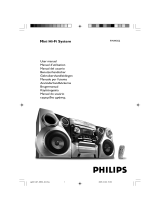
16
English
CD/MP3-CD Operations
3 Press OPEN•CLOSE to close the disc tray.
➜ READING is displayed as the CD player scans
the contents of a disc, and then the total number
of tracks and playing time (or the total number
of albums and tracks for MP3 disc) are shown.
Notes:
– Load the discs with the label side facing up.
–To ensure good system performance, wait until
the disc tray completely reads the disc(s) before
proceeding.
–For MP3 disc, the disc reading time may exceed
10 seconds due to the large number of songs
compiled into one disc.
Playing discs
To play current disc on the disc tray
● Press PLAY•PAUSE ÉÅ.
➜ All loaded discs will play once, then stop.
➜ During playback, the selected disc tray, track
number and elapsed playing time of the current
track are displayed.
➜ For mixed mode discs, only one mode will be
selected for playback depending on the
recording format.
Note:
– When playing a mixed mode disc, you may find a
very short mute track inserted into the total
number of tracks available in your disc.
To play the selected disc only
● In CD mode, press DISC 1/2/3 (or CD 1/2/3
on the remote control).
➜The current disc will play once, then stop.
To interrupt playback
● Press PLAY•PAUSE ÉÅ.
➜ The display freezes and the elapsed playing
time flashes when playback is interrupted.
● To resume playback, press PLAY•PAUSE ÉÅ
again.
To stop playback
● Press STOP Ç.
Te xt display during playback
In CD mode
● Press DISPLAY to show the current track
number and remaining playback time.
In MP3-CD mode
● Press DISPLAY repeatedly to show the current
album and track numbers followed by ID3
information (if available).
Replacing discs during playback
1 Press DISC CHANGE.
➜ The disc tray will open without interrupting
current playback.
2 To change the inner disc, press DISC
CHANGE again.
➜ "OPEN" is displayed and the disc will stop
playing.
➜ The disc tray will close to retrieve the inner
disc, then reopen with the inner disc accessible.
Selecting a desired track/passage
To search for a particular passage during
playback
● Press and hold à or á and release it when
the desired passage is located.
➜ During searching, the volume will be reduced.
To select a desired track
● Press í or ë repeatedly until the desired
track is displayed.
● If playback is stopped, press PLAY•PAUSE
ÉÅ to start playback.
Selecting a desired Album/Title
(MP3 disc only)
To select a desired album
● Press ALBUM -/+ (à or á) repeatedly.
To select a desired title
● Press TITLE -/+ (í / ë) repeatedly.
pg001-027_M352/371_55_Eng 2006.1.4, 16:1916




















